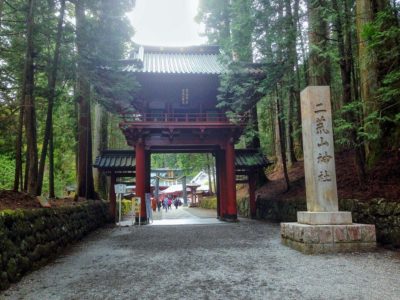One of Nikko ‘s most famous images is that of the red bridge spanning the river. This bridge belongs to the Futarasan Shrine nearby, which is a nice and quiet place to visit before or after you see the more famous Toshogu. Learn more about this tranquil place.
Futarasan History
The Futarasan shrine has been worshiped since ancient times as the center of beliefs connected with mountain worship. Large numbers of shrine buildings were erected especially during the medieval period. At the beginning of the Edo Period, the main shrine and the other shrine buildings were newly erected by the Tokugawa Shogunate. Of these, 23 buildings including the honden (main shrine) and the Shinkyo (sacred bridge), have been designated as Important Cultural Properties.
The Haiden
The Haiden was first constructed in 1619 and reconstructed later in 1645 when the Honden was relocated to its present location. Since then it has not undergone any alteration except for roofing materials that have been replaced for maintenance purposes. In contrast with the Honden, this construction shows a simple and serene style without colored patterns or decorations. This is the original style which the Haiden has retained since its foundation
The Shinkyo Bridge
The Shinkyo, or the sacred bridge, is known to have existed already on the present site spanning the Daiya River in the Muromachi Period. The exact date of its construction, however, is not clear. It was in 1636 that this bridge took on its present style as a vermilion-lacquered wooden bridge. Its massive stone piers piled down close to the riverbanks give the bridge firmness. Though demolished in a flash flood in 1902, it was reconstructed and restored to its 17th -century condition in 1904.


The Betsugu Takino-o-jinja Honden
The Betsugu Takino-o-jinja Honden, as the shrine legend tells us, was founded back in 825. It was relocated to the present location in 1646 and was later remodeled in 1713. It was destroyed in 1941 by a falling tree broken by a storm, but it was soon reconstructed. Reusing the surviving original structural members as much as possible it looks like before. This building has a door at the back overlooking Mt. Nyohosan — a unique feature provided for the worship of this sacred mountain.
The Betsugu Hongu-jinja Honden
Te Betsugu Hongu-jinja Honden is said to have originally been built in 808 and relocated to the present location in 850. Though this hall was burned to ashes twice in the past, it was immediately reconstructed each time to the original style. The Betsugu Hongu-jinja Honden that we see today is a 1685 reconstruction.
The Shin-yosha
The Shin-yosha was built in 1617 originally as a temporary worship hall of Toshogu. It was later relocated twice (in 1638 and in 1641) before it was set in the present location. Although it is a simply-designed bare wood construction that is small in scale, its significance is as great as any other building included in the nominated property. The Shin-yosha is the oldest remaining source of direct information about the architectural style used for Toshogu at its earliest stage of construction.
Your Japan Tour
As seasoned Japan experts, we create perfect Japan package tours including destinations like Nikko. Check out our group tours and private tours, or contact us to start planning your unforgettable holiday to this fascinating country. Japan is full of once-in-a-lifetime experiences, culture, history, nature, and delicious food!

